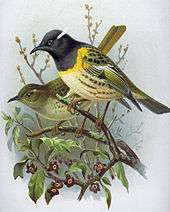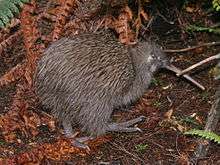Stitchbird
| Stitchbird | |
|---|---|
| Male | |
-1.jpg) | |
| Female in typical 'tail cocked' stance. | |
| Scientific classification | |
| Kingdom: | Animalia |
| Phylum: | Chordata |
| Class: | Aves |
| Order: | Passeriformes |
| Suborder: | Passeri |
| Family: | Notiomystidae Driskell et al., 2007 |
| Genus: | Notiomystis Richmond, 1908 |
| Species: | N. cincta |
| Binomial name | |
| Notiomystis cincta (Du Bus, 1839) | |
 | |
| Islands and sanctuaries where stitchbirds are present | |
The stitchbird or hihi (Notiomystis cincta) is a rare honeyeater-like bird endemic to the North Island and adjacent offshore islands of New Zealand. It became extirpated everywhere except Little Barrier Island but has been reintroduced to three other island sanctuaries and two locations on the North Island mainland. Its evolutionary relationships have long puzzled ornithologists, but it is now classed as the only member of its own family, the Notiomystidae.
Taxonomy and systematics
The stitchbird was originally described as a member of the primarily Australian and New Guinean honeyeater family Meliphagidae. It had remained classified as such until recently. Genetic analysis shows that it is not closely related to the honeyeaters and their allies and that its closest living relatives are within the endemic New Zealand Callaeidae.[2][3][4] In 2007 a new passerine family was erected to contain the stitchbird, the Notiomystidae.[3][5]
Description
The stitchbird is a small honeyeater-like bird. Males have a dark velvety cap and short white ear-tufts, which can be raised somewhat away from the head. A yellow band across the chest separates the black head from the rest of the body, which is grey. Females and juveniles are duller than males, lacking the black head and yellow chest band. The bill is rather thin and somewhat curved, and the tongue is long with a brush at the end for collecting nectar. Thin whiskers project out and slightly forward from the base of the bill.
Stitchbirds are very active and call frequently. Their most common call, a tzit tzit sound, is believed to be the source of their common name, as Buller noted that it "has a fanciful resemblance to the word stitch".[6] They also have a high-pitched whistle and an alarm call which is a nasal pek like a bellbird. Males give a piercing three-note whistle (often heard in spring) and a variety of other calls not given by the female.
Behavior and ecology
Research has suggested that they face interspecific competition from the tui and New Zealand bellbird, and will feed from lower-quality food sources when these species are present. The stitchbird rarely lands on the ground and seldom visits flowers on the large canopy trees favoured by the tui and bellbird (this may simply be because of the competition from the more aggressive, larger birds).
Their main food is nectar, but the stitchbird's diet covers over twenty species of native flowers and thirty species of fruit and many species of introduced plants. Important natural nectar sources are haekaro, matata, puriri, rata and toropapa. Preferred fruits include Coprosma species, five finger, pate, tree fuchsia and raukawa.
The stitchbird also supplements its diet with small insects.
Breeding
The stitchbird nests in holes high up in old trees.[7] They are the only bird species that mates face to face,[8] in comparison to the more conventional copulation style for birds where the male mounts the female's back.[9]
Status and conservation

The stitchbird was relatively common early in the European colonisation of New Zealand, and began to decline relatively quickly afterwards, being extinct on the mainland and many offshore islands by 1885. The last sighting on the mainland was in the Tararua Range in the 1880s.[10] The exact cause of the decline is unknown, but is thought to be pressure from introduced species, especially black rats, and introduced avian diseases. Only a small population on Little Barrier Island survived. Starting in the 1980s the New Zealand Wildlife Service (now Department of Conservation) translocated numbers of individuals from Hauturu to other island sanctuaries to create separate populations. These islands were part of New Zealand's network of offshore reserves which have been cleared of introduced species and which protect other rare species including the kakapo and takahe.
The world population is unknown; estimates for the size of the remnant population on Hauturu (Little Barrier Island) range from 600 and 6000 adult birds.[11] There are also translocated populations on Tiritiri Matangi Island, Kapiti Island, Zealandia, Maungatautari and the Waitakere Ranges. Attempts to establish populations on Hen Island, Cuvier Island and Mokoia Island failed. There is also a captive population at Mount Bruce. The Tiritiri Matangi population is growing slowly but more than half the chicks that hatch there die of starvation due to the lack of mature forest,[12] most of the island having been revegetated only since 1984–1994. Only the Little Barrier Island population is thought to be stable as of 2007.[13] This species is classified as Vulnerable (D2) by the IUCN[1] because of its very small range and population.
Reintroduction to mainland
In 2005, 60 stitchbirds were released in the Karori Wildlife Sanctuary near Wellington and in October that year, three stitchbird chicks hatched there, the first time for more than 120 years that a stitchbird chick had been born on mainland New Zealand. The hatchings were described as a significant conservation milestone by sanctuary staff who were hoping further chicks would be born there .[10]
In (local) autumn 2007, 59 adult birds from the Tiritiri Matangi population were released in Cascade Kauri Park, in the Waitakere Ranges near Auckland[12][14] and by the end of the year the first chicks had fledged there.[12]
References
- Angehr, George R. (1985): Stitchbird, NZ Wildlife Service
- Anderson, Sue (1993). "Stitchbirds copulate front to front" (PDF). Notornis. 40 (1): 14. Archived from the original (PDF) on 28 June 2007.
- Barker, F.K.; Cibois, A.; Shikler, P.; Feinstein, J.; Cracraft, J. (2004). "Phylogeny and diversification of the largest avian radiation". Proceedings of the National Academy of Sciences, USA. 101 (30): 11040–11045. doi:10.1073/pnas.0401892101. PMC 503738. PMID 15263073.
- BirdLife International (BLI) (2007a): Hihi returns home after 125 years. Includes photo of adult male. Version of 23 February 2007. Retrieved 26 February 2007.
- Buller, Walter L. (1888): Fam. TIMELIPHGIDÆ — Pogonornis Cincta. — (Stitch-Bird.), in his A History of the Birds of New Zealand, Second Edition. London: Walter Buller. Retrieved 26 April 2009.
- Driskell, A.C.; Christidis, L.; Gill, B.; Boles, W.E.; Barker, F.K.; Longmore, N.W. (2007). "A new endemic family of New Zealand passerine birds: adding heat to a biodiversity hotspot". Australian Journal of Zoology. 55: 1–6.
- Ewen, J.G.; Armstrong, D.P. (2002). "Unusual sexual behaviour in the Stitchbird (or Hihi) Notiomystis cincta"". Ibis. 144 (3): 530–531. doi:10.1046/j.1474-919X.2002.00079.x.
- Ewen, J.G.; Flux, I.; Ericson, P.G.P. (2006). "Systematic affinities of two enigmatic New Zealand passerines of high conservation priority, the hihi or stitchbird Notiomystis cincta and the kokako Callaeas cinerea" (PDF). Molecular Phylogenetics and Evolution. 40: 281–284. doi:10.1016/j.ympev.2006.01.026. PMID 16527495.
- Gregory, Angela (2007): Waitakere hihi prepare for flight. New Zealand Herald 17 December 2007.
- Gregory, Angela (2007): Mysterious bird in a league of its own. New Zealand Herald 17 March 2008.
- Karori Wildlife Sanctuary (KWS) (2005): First hihi hatched in the wild on mainland NZ. Version of 2005-OCT-31. Retrieved 26 February 2007.
- Rasch, G (1985). "The ecology of cavity nesting in the stitchbird (Notiomystis cincta)"". New Zealand Journal of Zoology. 12 (4): 637–642. doi:10.1080/03014223.1985.10428313.
Notes
- 1 2 BirdLife International (2015). "Notiomystis cincta". IUCN Red List of Threatened Species. Version 2015.2. International Union for Conservation of Nature. Retrieved 19 February 2017.
- ↑ Barker et al. 2004
- 1 2 Driskell et al.' 2007
- ↑ Ewen et al., 2006
- ↑ Gregory, A. 2008
- ↑ Buller 1888, p. 102
- ↑ Rasch, 1985
- ↑ Anderson, 1993
- ↑ Ewen & Armstrong 2002
- 1 2 KWS 2005
- ↑ Hihi/Stichbird (Notiomystis cincta) recovery plan 2004–2009
- 1 2 3 Gregory, 2007
- ↑ BirdLife International 2007b
- ↑ BLI, 2007a
External links
| Wikimedia Commons has media related to Notiomystis cincta. |
- Karori Wildlife Sanctuary: Stitchbird Facts
- Birdlife International: Species factsheet
- "Hihi/stitchbird (Notiomystis cincta) recovery plan 2004–09 (Threatened Species Recovery Plan 54)" (PDF). Department of Conservation, Wellington, New Zealand. 2005. Retrieved 5 September 2007.
- Hihi conservation

